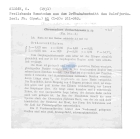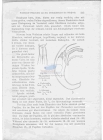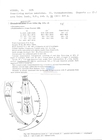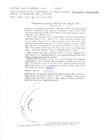
|
World Database of NematodesLinked to the Marine Biology Section, UGent |
| Start | Browse taxonomy |
Search taxonomy |
Search literature |
Search distributions |
Identification keys |
Media gallery | Editors | Statistics | Citations | Match taxa | Contact | Login |
WoRMS taxon detailsChromadorina germanica (Bütschli, 1874) Wieser, 1954
122280 (urn:lsid:marinespecies.org:taxname:122280)
accepted
Species
Chromadora droebachiensis Allgén, 1931 · unaccepted
Chromadora germanica Bütschli, 1874 · unaccepted
Chromadora minor Cobb, 1894 · unaccepted
Chromadorina minor Wieser, 1954 · unaccepted
Heterochromadora germanica Wieser, 1951 · unaccepted
Prochromadorella germanica (Bütschli, 1874) De Coninck & Stekhoven, 1933 · unaccepted (synonym)
marine, fresh
(of Chromadora germanica Bütschli, 1874) Bütschli, O. (1874). Zur Kenntnis der freilebenden Nematoden, insbesondere der des Kieler Hafens. Abhandlungen der Senckenbergischen Naturforschenden Gesellschaft. [details]
Type locality contained in Germany
type locality contained in Germany [details]
Distribution Recorded: North Sea, Mediterranean Sea; Puget Sound, Washington; Florida, New Jersey and Rhode Island; Avenport, Nova Scotia
Distribution Recorded: North Sea, Mediterranean Sea; Puget Sound, Washington; Florida, New Jersey and Rhode Island; Avenport, Nova Scotia [details]
Nemys eds. (2025). Nemys: World Database of Nematodes. Chromadorina germanica (Bütschli, 1874) Wieser, 1954. Accessed through: World Register of Marine Species at: https://www.marinespecies.org/aphia.php?p=taxdetails&id=122280 on 2025-04-04
Date action by
Nomenclatureoriginal description
(of Chromadora minor Cobb, 1894) Cobb, N. A. (1894). Tricoma and other nematode genera. The proceedings of the Linnean Society of New South Wales (Second Series). Vol. VIII, 389-421 -With 28 plates. [details] original description (of Chromadora germanica Bütschli, 1874) Bütschli, O. (1874). Zur Kenntnis der freilebenden Nematoden, insbesondere der des Kieler Hafens. Abhandlungen der Senckenbergischen Naturforschenden Gesellschaft. [details] original description (of Chromadorina minor Wieser, 1954) Wieser, W. (1954). Free-living marine nematodes II. Chromadoroidea. Acta Univ. lund (N.F.2). 50 (16): 1-148. (look up in IMIS) [details] Available for editors original description (of Heterochromadora germanica Wieser, 1951) Wieser, W. (1951). Untersuchungen über die algenbewohnende Mikrofauna mariner Hartböden. I. Zur Ökologie und Systematik der Nematodenfauna von Plymouth. Öst. zool. Z. 3 (3/4): 425-480. [details] Available for editors basis of record De Smet, G.; Vincx, M.; Vanreusel, A.; Vanhove, S.; Vanaverbeke, J.; Steyaert, M. (2001). Nematoda - free living. In: Costello, M.J. et al. (Ed.) (2001). European register of marine species: a check-list of the marine species in Europe and a bibliography of guides to their identification. Collection Patrimoines Naturels, 50. 161-174., available online at https://www.vliz.be/nl/imis?refid=26605 [details] new combination reference Wieser, W. (1954). Free-living marine nematodes II. Chromadoroidea. Acta Univ. lund (N.F.2). 50 (16): 1-148. (look up in IMIS) [details] Available for editors Ecologyecology source
Fonsêca-Genevois, V.da., P.J. Somerfield, M.H. Baeta-Neves, R. Coutinho & T. Moens. (2006). Colonization and early succession on artificial hard substrata by meiofauna. Marine Biology 148(5):1039-1050., available online at https://doi.org/10.1007/s00227-005-0145-8 [details] Available for editors ecology source Soetaert, K.. M. Vinckx, J. Wittoeck & M.Tulkens. (1995). Meiobenthic distribution and nematode community structure in five European estuaries. Hydrobiologia. 311: 185-206. (look up in IMIS) [details] Available for editors Otheradditional source
Hopper, B. E. (1969). Marine nematodes of Canada. II. Marine nematodes from the Minas Basin - Scots Bay area of the Bay of Fundy, Nova Scotia. Can. J. Zool. 47(4): 671-690. [details] Available for editors
additional source Various Authors (2000). Nematode filing cabinet of the Marine Biology Section Ugent - in combination with the NemasLan Ms-Access database (published on CD-Rom, 2000) (look up in IMIS) [details] additional source Tietjen, J. H.; Lee J. J. (1977). Feeding Behavior of Marine Nematodes. Ecology of Marine Benthos, B.C. Coull. pp. 21-35. [details] Available for editors additional source Moens, T.; Vincx, M. (2000). Temperature and salinity constraints on the life cycle of two brackish-water nematode species. Journal of Experimental Marine Biology and Ecology. 243(1): 115-135. (look up in IMIS), available online at https://doi.org/10.1016/s0022-0981(99)00113-6 [details] Available for editors additional source Vitiello, P. (1985). Structure des peuplements de Nematodes en milieu lagunaire pollué. Actes du 110e congrès national des sociétes savantes fascicule II Extrait Paris cths 1985. [details] Available for editors additional source Zhou, H. (2001). Effects of leaf litter addition on meiofaunal colonization of azoic sediments in a subtropical mangrove in Hong Kong. Journal of Experimental Marine Biology and Ecology, Elsevier, Amsterdam 256(1):99-121. [details] Available for editors additional source Liu, J.Y. [Ruiyu] (ed.). (2008). Checklist of marine biota of China seas. China Science Press. 1267 pp. (look up in IMIS) [details] Available for editors additional source Warwick, R. M. (1971). Nematode associations in the Exe estuary. J. mar. biol. Ass. U. K. 51: 439-454. [details] Available for editors additional source Heip, C.; Herman, R.; Vincx, M. (1983). Subtidal meiofauna of the North Sea: A review. Biol. Jb. Dodonaea. 51: 116-170. (look up in IMIS) [details] Available for editors additional source Van de Velde, B. (2003). Evaluatie en opvolging van een strandverstoringsexperiment met behulp van mariene nematoden. Lic. Thesis UGent. [details] Available for editors additional source Gheskiere, T. (2000). Structurele diversiteit van nematodengemeenschappen van de Bligh Bank (Zuidelijke Bocht van de Noordzee). [details] Available for editors additional source Gheskiere, T., M. Vincx, G. Pison & S. Degraer. (2006). Are strandline meiofaunal assemblages affected by a once-only mechanical beach cleaning? Experimental findings. Marine Environmental Research. 61(3): 245-264. (look up in IMIS), available online at https://doi.org/10.1016/j.marenvres.2005.10.003 [details] Available for editors additional source Integrated Taxonomic Information System (ITIS). , available online at http://www.itis.gov [details] additional source Coomans, A. V. (1989). Overzicht van de vrijlevende nematofauna van België (Nematoda). [The freeliving nematofauna of Belgium: a review.]. In Wouters, K.; Baert, L. (Ed.): Invertebraten van België = Invertébrés de Belgique: Verhandelingen van het Symposium "Invertebraten van België" = Comptes rendus du Symposium "Invertébrés de Belgique" = Proceedings of the Symposium "Invertebrates of Belgium". Brussel, 25-26 november 1988. Koninklijk Belgisch Instituut voor Natuurwetenschappen: Brussel, Belgium. 43-56. (look up in IMIS) [details]  Present Present  Present in aphia/obis/gbif/idigbio Present in aphia/obis/gbif/idigbio  Inaccurate Inaccurate  Introduced: alien Introduced: alien  Containing type locality Containing type locality
Unreviewed
Diet bacteria, fungi and other nematodes [details]Dimensions Length: male 0.77 mm; Maximum width: 29-31 u; Head: 11-12 u wide [details] Distribution Recorded: North Sea, Mediterranean Sea; Puget Sound, Washington; Florida, New Jersey and Rhode Island; Avenport, Nova Scotia [details] Habitat free-living or bottom dwelling [details] Importance useful in determining environmental quality [details] Reproduction separate sexes; fertilization internal, eggs may be retained until hatching. Young appear as juvenile worms (not larvae). [details]
Original description (NemasLan)
Original description (NemasLan) To Biodiversity Heritage Library (3 publications) To European Nucleotide Archive, ENA (Chromadorina germanica) To GenBank (5 nucleotides; 0 proteins) To PESI To USNM Invertebrate Zoology Nematoda Collection (5 records) To ITIS |
Web interface and database structure initially created by Tim Deprez; now hosted and maintained by VLIZ
Page generated 2025-04-04 · contact: Tânia Nara Bezerra or info@marinespecies.org







